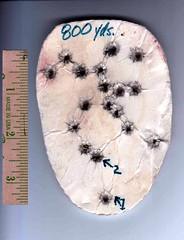wisdeerkiller
Active Member
so my question is how accurate do you need to be for shooting long range?(1000-1300yds)
my gun is a remington 700 sps varmint in 308. (1 in 12 twist).
i am shooting 168gr sierra HPBT with RL-15 powder.
shot through my chronograph.
these are at 100yds.
the center group is 42.5gr at 2400fps and is .95".
the bottom left is 43gr at 2450fps and is the best group at .425".
the upper left is 43.5gr at 2500fps and is .815".
the upper right is 44gr at 2550fps and is 1.11". (MAX LOAD IS 44.8gr)
the bottom right 175 SMK at 44gr at 2475fps and is 1.45"(MAX LOAD IS 44.3gr)
If accuracy is the way to go i should go with 43gr of powder but velocity is only 2450.
50fps is about 2 foot difference at 1000yds.
would like to switch to 175gr buy have 300 rounds of 168gr right now.
any suggestions what i should do?
thanks in advance.
my gun is a remington 700 sps varmint in 308. (1 in 12 twist).
i am shooting 168gr sierra HPBT with RL-15 powder.
shot through my chronograph.
these are at 100yds.
the center group is 42.5gr at 2400fps and is .95".
the bottom left is 43gr at 2450fps and is the best group at .425".
the upper left is 43.5gr at 2500fps and is .815".
the upper right is 44gr at 2550fps and is 1.11". (MAX LOAD IS 44.8gr)
the bottom right 175 SMK at 44gr at 2475fps and is 1.45"(MAX LOAD IS 44.3gr)
If accuracy is the way to go i should go with 43gr of powder but velocity is only 2450.
50fps is about 2 foot difference at 1000yds.
would like to switch to 175gr buy have 300 rounds of 168gr right now.
any suggestions what i should do?
thanks in advance.


